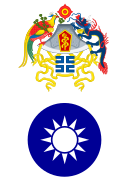Stanley Gibbons Stamps of the World 2015.
Well look what has arrived today!!! I am very excited indeed to own my first copy of the simplified Stanley Gibbons reference series of books - 2015.
It is, however the simplified catalogue but for the moment this seems more than enough reference material to enable me to start to identify the stamps in my Chinese collection.


I now wonder whether he ordered the album by date or by Province. Well we shall have to see!! But before then it may be useful to try to understand how and why these provinces came into existence and why the Stanley Gibbons catalogue arranges its stamps this way!
Motto
全世界無產階級和被壓迫的民族聯合起來 (a slogan for the communists)"Workers of the world, unite!"
After a quick search, it is immediately obvious that there is a good deal of fascinating history going on here. It is quite easy to forget that China was not always a communist constitution. For those who want to read more about the history of China and how it came to be the way it is today, I have managed to track down a number of articles on Wikipedia. A snap shot of the Republic of China and dates is given below but the full article can be found by clicking the link below:
The Republic of China (traditional Chinese: 中華民國; simplified Chinese: 中华民国; pinyin: Zhōnghuá Mínguó; Wade–Giles:Chung1-hua2 Min2-kuo2) was the East Asian state that governed the present-day territories of China, Mongolia and Taiwan at differing times between 1912 and 1949. As an era of Chinese history, it was preceded by the last imperial dynasty of China, the Qing dynasty. Its end was marked by the conclusion of the Chinese Civil War, which saw the division of the state. The losing Kuomintang retreated to the island of Taiwan, which it continued to call the "Republic of China", today more commonly known as Taiwan. The winning Communist Party of China controlled the remaining territory on the mainland, and there founded the People's Republic of China, more commonly known as China.
Just flicking through the China section of the Stanley Gibbons catalogue it is easy to see that the above segregation of an entire country for more than 40 years, helped to create what is one of the most amazing postage stamp biographies in the world This is of course owing in part to the different personalities running their own share of China and also as an advertisement for their political ideology. My album shows stamps which demonstrate an alliance to Russia. Some depict Joseph Stalin and Vladimir Lenin, and others show them alongside or shaking hands with Mao Tse-Tung.
 |
| One-yuan bill, with Lenin's image in the center |
As I have learned these stamps point to ones which were produced in the Chinese Soviet Republic, which existed as an unrecognizable state between the dates 1931-1937. You can access a potted history of the Chinese Soviet Republic via the link below:
I am not too sure as yet but I think that this may refer to the areas that produced the People's Post, but a little bit more research needed here until I can confirm this.
So I am off to assign the unique Stanley Gibbons reference number to each of my stamps on page one, this in itself may take a little time and when I have done this I shall post a picture of page one of my collection along with their SG number. We shall also see what area the stamp originated from and its current valuation where applicable.
Wish me luck!!!





No comments:
Post a Comment